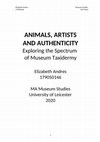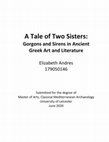Papers by Elizabeth Andres

When does taxidermy become “art” instead of “natural history”? When does a taxidermy specimen tra... more When does taxidermy become “art” instead of “natural history”? When does a taxidermy specimen transition from being an “animal” to an “object”? Are these categories mutually exclusive? This thesis explores these questions and seeks to demonstrate that all taxidermy involves artistic illusion, and the differences in how we interpret that illusion are dependent on the context in which it is encountered. Using the idea of an artistic spectrum of taxidermy as a framework, we can explore how different types of taxidermy fall along the spectrum from highly naturalistic to more explicitly artistic. The more naturalistic a work appears, the less visible is the artist who created it. The more visible the artist, the more we are reminded that what we are looking at is merely a construct of nature, a once living creature which is now dead, yet which still possesses power as an authentic or “real” being. After an initial discussion of the concepts of nature, death, and authenticity, this thesis travels along the spectrum of taxidermy: starting with traditional habitat dioramas and vintage dramatic scenes; moving through reconstructions of rare, extinct, and fantastical creatures; and concluding with several examples of contemporary artists working with taxidermy in compelling new ways. Additional insight is provided through individual interviews conducted with museum taxidermists and taxidermy artists, as well as via an online survey assessing people’s attitudes toward taxidermy before and after participating in a visual slide show exposing them to a wide range of taxidermy creations. This project seeks to break down barriers erected by the false dichotomy between art and science, and to expand our understanding of how nature can be represented and reflected in museums through the art of taxidermy.

Despite rarely appearing together in art and mythology, Gorgons and Sirens have a great deal in c... more Despite rarely appearing together in art and mythology, Gorgons and Sirens have a great deal in common. Although many hybrid creatures evolved in the human imagination over time, Gorgons and Sirens have had a particularly interesting journey from being depicted primarily as fearsome monsters to appearing as something much more human, and even benevolent, in different time periods and in different contexts. Both belong to groups of sisters, and share a primordial connection to water through their parentage. Both groups of sisters reside on remote islands in distant seas, not creatures you would happen upon by accident, but figures that are encountered by heroes and travelers. Both are inherently associated with the senses: the Gorgon’s gaze, the Siren’s song. And both are intimately connected with death and the underworld. Looking closely at iconography and literary sources between the 7th and 4th centuries BCE, this thesis aims to explore these areas of overlap, and to examine whether the development of Gorgons and Sirens in the visual record was a linear process, or if it was instead more complex and dependent on context.










Uploads
Papers by Elizabeth Andres